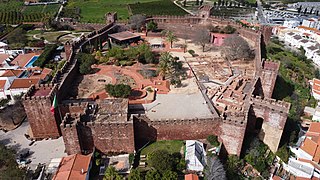
The Algarve is the southernmost NUTS II region of continental Portugal. It has an area of 4,997 km2 (1,929 sq mi) with 467,495 permanent inhabitants and incorporates 16 municipalities.

Faro is a municipality, the southernmost city and capital of the district of the same name, in the Algarve region of southern Portugal. With an estimated population of 60,995 inhabitants in 2019, the municipality covers an area of about 202.57 km2 (78.21 sq mi).

Silves is a city and municipality in the Portuguese region of Algarve, in southern Portugal. The population of the entire municipality of Silves in 2011 was 37,126, in an area of 680.06 km2. The urbanized area of the city proper has approximately 11,000 inhabitants. Silves is the former capital of the Kingdom of the Algarve (1249–1910), a nominal kingdom within the Kingdom of Portugal (1139-1910), and is of great historical importance.

The Kingdom of the Algarve, after 1471, Kingdom of the Algarves, was a nominal kingdom within the Kingdom of Portugal, located in the southernmost region of continental Portugal, until the end of the monarchy in 1910.

Algoz is a town and the seat of the civil parish of Algoz e Tunes in the municipality of Silves, in Algarve, Portugal. It has about 3000 inhabitants.

São Brás de Alportel is a town and municipality in the District of Faro, Algarve region, in Portugal. The population in 2011 was 10,662, in an area of 153.37 km². The present Mayor is Vítor Guerreiro, elected by the Socialist Party. The municipal holiday is June 1.

São Marcos da Serra, also known simply as São Marcos, is a village and the seat of the homonymous civil parish in the municipality of Silves, in Algarve region, Portugal. The population of the entire civil parish in 2011 was 1,352, in an area of 166.07 km2.

The Castle of Silves is a castle in the civil parish of Silves in the municipality of Silves in the Portuguese Algarve. It's believed that the first fortifications were built upon a possible Lusitanian castro, by the Romans or Visigoths. Between the 8th and 13th centuries, the castle was occupied by the moors who expanded it, making it one of the best preserved Moorish fortifications in Portugal, resulting in its classification as a National Monument in 1910.

The Silves Cathedral is a former cathedral in the city of Silves, in the Algarve region of southern Portugal. A mosque, built during the Moorish rule of the Iberian Peninsula, was originally located in its current place, and was later mostly restructured and converted into a Catholic cathedral after the Reconquista. Although having some Baroque characteristics, it is mostly Gothic in nature and it is considered to be the main Gothic monument in the Algarve and one of the most important landmarks in southern Portugal. It was classified as a national monument on June 29, 1922.

The Fort of São João do Arade, sometimes referred to as the Castle of Arade, is a medieval fortification situated in the civil parish of Ferragudo in the Portuguese Algarve municipality of Lagoa.
Porches is a civil parish/freguesia in the municipality of Lagoa in Portugal, about 10 km east of the city of Lagoa. The population in 2011 was 2,011, in an area of 15.64 km2. It was elevated to the status of a town on July 12, 2001.

The Church of Our Lady of the Incarnation is a church situated in the civil parish of Porches, in the municipality of Lagoa in the Portuguese region of Algarve.

The Castle of Alcantarilha is a medieval fortress and its remnant walls in Portugal, in the civil parish of Alcantarilha, municipality of Silves, in the Portuguese Algarve region of southwestern Iberia. It is a little-known monument, now in ruins, used for the protection of the people of the village and surrounding area from attacks by north African pirates.
Patrick Swift (1927–1983) was an Irish painter who worked in Dublin, London and the Algarve, Portugal.
Porches Pottery is a producer of hand-painted pottery in the town of Porches, in the Algarve region of Portugal. The pottery style was founded in 1968 by artists Patrick Swift and Lima de Freitas, in order to revive a traditional Algarve pottery industry. Swift and de Freitas chose Porches for its history as a pottery centre, dating back for many centuries, and for its clay pits.
Katherine Swift (1956–2004) was an Irish-born Portuguese painter, illustrator and ceramicist.

The Castle of Lagos is a medieval castle located in the municipality of Lagos, Portugal. Its walls surrounded the entire city of Lagos, providing the town its main means of defence.

Praia da Arrifana is a beach within the Municipality of Aljezur, in the Algarve, Portugal. The beach is on the western Seaboard in the north west of the Algarve. The beach is 6.0 miles (9.7 km) south south west of the village of Aljezur, and is 71.0 miles (114.3 km) north west, by road, from the regions capital of Faro. The beach of Praia da Arrifana is inside the Vicentine Coast Natural Park, an area of outstanding natural beauty. Praia da Arrifana has been designated a blue Flag beach (2012).
Ana Margarida Costa Arruda dos Santos Gonçalves is a Portuguese historian and archaeologist specialized in Phoenician-Punic archaeology.

Fort São Vicente is a military monument in Sagres, in the Algarve region of Portugal. It consists of the remains of a fortification, with a lighthouse inside. It was built in the 16th century to protect a coastal strip and an existing monastery on the site. In 1587 it was destroyed by British privateer Francis Drake, and rebuilt in 1606. In the mid-19th century, a lighthouse was built on the site, which was replaced by a new one in the early 20th century. In the mid-2000s, Cape São Vicente was closed to the public for construction work.














